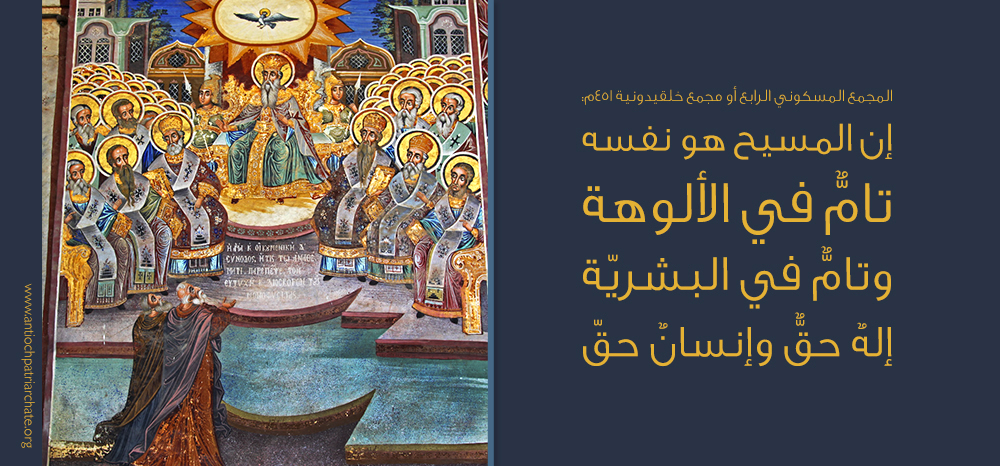
The Fourth Ecumenical Council
• The Fourth Ecumenical Council
On the 13th of July, if it falls on a Sunday or any Sunday that follows, the Orthodox Church commemorates the 360 Fathers of the Fourth Ecumenical Council who met in Chalcedon in 451 AD.
Introduction:
In 451 A. D., the Fathers of the Church from all over the world gathered to discuss an essential dogmatic topic associated with the faith in our Lord Jesus Christ. The Synod led to the schism between the Roman Orthodox Church on one side, and the Copts, the Armenians, and the Syriac, on the other. Consequently, the unity of these churches was broken.
The opponents of the Council refused the expression “two natures in our Lord Jesus Christ” because they understood the word “nature” physis as equivalent to “Person” Hypostasis; consequently, it is impossible for our Lord Jesus Christ to have two persons, or natures, especially that at the time, the statement by St. Cyril (410-444 AD) “one nature to God the incarnated word” was prevailing.
Historians and researchers claim that several factors lead to the schism above, besides the differences in language. Ethnic and political factors contributed to the schism, besides the tendency to independence which was well known among the Armenians, the Syrians, and the Alexandrians, in regard of the Roman Empire. We can also add another factor that resulted from the 4th Council held in Ephesus in 449 which was known as the Robber Council.
The Church confirmed its faith in the unity of the person of Christ, and in the two natures in Christ (the divine nature, and the human nature).
- Reasons for convening the Fourth Ecumenical Council:
Eutyches, an abbot of a Monastery in Constantinople with 300 monks, declared with the support of Dioscorus, Patriarch of Alexandria, that the two natures in Christ (the Divine and the Human), have been united to become one, after the incarnation of the Lord, in a way that the human one was absorbed or swallowed up by the divine nature.
Eutyches justified his statement by quoting St. Cyril of Alexandria’s expression: “The one nature incarnate of God the Word”. Maybe a certain Linguistic misunderstanding among the Christians of the time (especially in Constantinople, Antioch, and Alexandria) had contributed to feeding in, the schism, that was brought about, by the Council, with the exception of some political and ethnic factors.
Eutyches believed in the existence of two natures in Christ before his incarnation. In that, He could have been influenced by Origen’s teaching on the eternal existence of the Souls. Yet, he only acknowledged one nature after the incarnation, believing that the divinity of Christ had absorbed his humanity, which melted in the divinity, just as one drop of honey can melt in the sea.
- St. Cyril and Monophysitism
No doubt, St. Cyril had in mind the One Person in Christ when he said “nature”(physis: in Greek), for he used to say that Jesus is one nature composed of two elements: the divine and the human. That is to say, Jesus is one person, God and Man. But in Antioch and Constantinople, the word (physis = nature) means the characteristics or properties that define beings and are distinguished from one another. In this sense, the divine is distinguished from the human by having power, eternity, infinity of existence, besides the ability to create things ex-nihilo. To this day, this is the notion of the word “physis”: the properties and characteristics of a being define his nature.
- The Council of Constantinople 448
In a council held in Constantinople in 448 and presided by Saint Flavian the Confessor and Archbishop of Constantinople), bishop Eusebius of Dorylaeum, filed a written complaint against the teachings of Eutyches. Eusebius accused Eutyches of heresy. The complaint was accepted and Eusebius, who had earlier read a volume of three tomes called “the Beggar “, in reference to Eutyches. The Volume was written by Theodoritus the Bishop of Cyr - whose writings against Saint Cyril shall be condemned by the 5th ecumenical Council. It was published the year 447, and on whose basis the teachings of Eutyches were considered non-Orthodox.
This Council proved that the teachings of Eutyches were corrupt; consequently he was deposed and defrocked (excommunicated); but he did not comply appealing to the synods in Rome, Alexandria, and Jerusalem, for acquittal and vindication. And .Dioscorus (of Alexandria), in a local synod persisted at the originality of Eutyches’ ‘teachings”, and Refused the excommunication taken against Eutyches .He sent him back as a priest and abbot, to his Monastery .But Leo the Pope of Rome, took a step contrary to Dioscorus, and acknowledged the originality of the Council of Constantinople 448 issuing an encyclical in which he condemned Eutyches’ teachings, explaining the Hypostasis of the divine Word in two natures.
• The robbers Council in Ephesus 449
It is well known that Eutyches was in good relations with the emperor Theodosius, and this was because of his minister Chrysafios. Eutyches was the spiritual father of the minister. So he could easily persuade the emperor to call for another council to discuss his teachings. This was done and realized, in Ephesus 449.
The Council of Ephesus 449 was presided by Dioscorus (patriarch of Alexandria), who could impose himself, and his ideas, on 135 of the Fathers who attended the council. This was vacillated by the support he received from some biased Egyptian bishops who sympathized with Eutyches, besides the interference of some monks under the leadership of Barsumas the Syrian.The bishops in the council justified Eutyches and even acquitted him of all charges attributed to him. They excommunicated some of his opponents like Flavian (patriarch of Constantinople), who died from his wounds on his way to exile (after being fiercely beaten up during the sessions of the Council), with Domnus the Antioch an and Theodoritus.
The legates of Rome could escape. They went back to their country informing the Pope Leo the Great of what had occurred. He quickly called for a Synod in Rome, and called the Council of Ephesus “the Robber Council”. The bishop of Rome tried several times to persuade the Emperor Theodosius to call for an ecumenical Council in Italy, but in vain.
- Convening the Council:
The Emperor Theodosius II died the year 450 and was succeeded by his sister Pulcheria who consented to get married to Marcian the chief of the army to help with her in running the state, provided that she remains a virgin. Marcian returned the bishops in exile and responded to the demand of Pope Leo the Great. He called for a council in “Chalcedon”which the Church in the East and in the west called “the 4th ecumenical Council”.
The Council of Chalcedon was held the year 451 and 630 bishops attended to invalidate the Robber Council of Ephesus. They condemned the Eutychian and the Nestorian heresies and excommunicated Dioscorus the bishop of Alexandria for declining from appearing before the Council in spite of being called by them thrice. This was considered a disrespectful behavior towards the Council. The Fathers accepted warmly the message sent by Pope Leo, which Dioscorus had abstained from reading in the Council of Ephesus. In the message, The Pope distinguishes clearly between the two natures, emphasizing the presence of the two natures in one hypostasis. They also expressed their faith in the One Son, perfect in terms of his divinity and humanity: the true God-Man”. They confessed the unity of the two natures without division, separation and confusion….and that this union is real and true in terms of essence and constitution”. They stressed their faith that there is one hypostasis in Christ with two distinguished natures: the divine and the human. Among the most important conclusions in the definition, that Christ is “perfect God and perfect Man. A true God and a true Man. Equal to the Father in Godhead and equal to us in humanity, like us in everything except in sin. He was begotten from the Father as God pre-eternally and in the last days He was born of the virgin Mary the Mother of God (Theotokos), according to humanity. He is one. He is the Messiah, the Son of God, the Lord who must be confessed in two natures united without confusion nor change, without division nor separation. He was not divided into two persons but he has always been the Only Begotten God the Word and the Lord Jesus Christ”.
In this Chalcedonian definition, the Fathers of the Council re-emphasized the Creed. They also emphasized two other important things:
-The unity of the person in the Lord Jesus Christ. This is indicated in the “he is one and the same”. The Lord Jesus Christ is One. He is the Word of God eternally born from the eternal Father before the ages, and born from Mary in humanity.
-That the two natures in Christ sustain their properties amidst the unity of the person. The word became Flesh assuming all the Human Nature except “sinning”, without giving up or abandoning his Divine Nature. The Chalcedonian Council acquitted Theodoritus of Cyre, Eva of Rah, and some other bishops after they approved excommunicating Nestorius and confessed that Mary is the Mother of God (Theotokos), refusing to divide the Only-Begotten Son of God. The Council legislated 30 Canons, among which is Canon 28, that gave equal to dignity the bishops of the two Romes, the old (Rome) and the new (Constantinople). The Council also released obtained an autocephalous status giving it the 5th rank among the great Churches.
Conclusion:
Although the goal of the Chalcedonian Fathers was to decide, once and for all, on the unity of the Person in Christ, emphasizing his two natures in him, the Eastern Churches following the Coptic, Armenian, and Syrian traditions, still consider that the words used in the Council highlight “two persons in Christ”. This is what the Chalcedonians rejected, emphasizing the unity of one person in Christ. That is why it is better not to call these Churches as monophysites (believing in one nature only), rather using the expression (non-Chalcedonian) in hope that all complications be removed.
- St. Euphemia and the Fourth Ecumenical Council:
When the 630 Fathers of the 4th Ecumenical Council met in Chalcedon in 451, with the support of both the pious emperors Marcian and Pulcharia in the large Basilica of St Euphemia, the Fathers had wanted to reject all heretic ideas of the Archimandrite Eutyches who had been supported by Dioscorus of Alexandria. As they had wished to have a decisive and divine resolution, the Holy Patriarch Anatolius suggested that each of the two parties write down their Creed. Then both Creeds shall be put into the coffin with the Relics of St. Euphemia. When the two Creeds were put on her chest, the coffin was shut down while the Fathers went to pray. Eight days later, all the fathers returned to the Coffin. When they opened it their surprise, they found out that St Ophemia was holding tight the Orthodox Creed to her chest, while the other one was at her feet.
There is an ancient story associated with what happened: The Holy Fathers laid the two documents in the coffin. All of a sudden, St. Euphemia stretched out her hand to take the orthodox document. Then she kissed it and handed it to the Holy Fathers.
The Fathers of the Council wrote a letter to St Leo the 1st and said: “St Ophemia received from us the dogmatic definition, and handed it down to her bridegroom through both the emperor and the empress so as to emphasize that it is what she believes in. In this way, she confirmed by hand and tongue, the decree signed by all the attendants in the Council.
The Church Fathers chose a gospel to be read in relation to this Council. It is Christ’s saying: “You re the light of the world”. This is a great expression: “the light of the world”. Without light, our eyes cannot see. Vision needs light. There are the sun, the planets, and other lights that are produced by electricity. All these emit light. All these are because God created the light when he created the universe. But the light meant here is additional, exceptional, and can reveal to us that man who can be seen by the light that comes from inside, carries God, carries Christ and there is the light of divinity in him which is the source of light coming from him. And it is what we need today to have “light”. This light is helps us see one another. The Lord says after that: “let your light shine on people so that they can see your work and glorify your Father in the heavens”. We are the means that can help others by the light we carry to communicate with the light that comes from God the Father, to praise him and glorify him. That is how we can live as real family with God in heaven as our Father and inspirer. We are the members of God’s Family. We love one another; we serve one another; we respond to the needs we all have with clean hearts and clean hands.
This way we can make God’s Will come true. The gospel which we heard was chosen to describe the Holy Fathers (whose number is 630) of the Fourth Ecumenical Council in Chalcedon. These Fathers were really the light of the world. We abide by their teachings which were handed down to us. By their teachings we realize that it is the real enlightenment, for it comes from the Light that inspired their minds and hearts to write down the Christian dogma and define the path to the kingdom of God.
Let us be like them to imitate them. Let them be our example and model, through Christ, who is lives in them, that He might dwell in us too.








